Ivan Kuskov
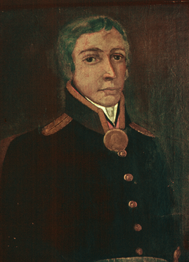
The founder and first manager of Fort Ross, Ivan Kuskov, was from Totma, Russia. His remarkable biography spans the globe and the centuries, place and time. Learn more about Ivan and also Ekaterina Kuskov, the little known First Lady of Fort Ross. Enter their Russian home, their Kuskov House Museum, and learn about this and other interactive and innovative museums in Totma and the many goodwill initiatives that connect Totma and Fort Ross, then and now.
We've also included a short piece by Lauren Peters, Alaska Native Advisor, which reflects a very different perspective on Ivan Kuskov.
Ivan Kuskov & His Enduring Russian-America Legacy:The Bridge Between Totma and Fort Ross
Ivan Aleksandrovich Kuskov was born in 1765, in the town of Totma, 400 miles northeast of Moscow, a few years after Catherine the Great had begun her rule. Fifty-eight years later, Kuskov would die in Totma and be buried there. But he did not spend his life there. Ivan Kuskov saw much of the world; he explored new territories, and had many grand adventures, some of them fraught with great difficulty and danger. Without a doubt, his greatest achievement was the founding of Colony Ross, here on the shores of northern California, on the other side of the world from Totma.
Who Was Ivan Kuskov?, - E. Breck Parkman
At age 22, Ivan Aleksandrovich Kuskov(1765-1823) left his ancient Russian North hometown of Totma(c.1137), on the Sukhona River, near Vologda, north of Moscow. Like so many other local seafarers and merchants before him that were also pulled into the lucrative fur trade (twenty North American expeditions originated in Totma), Kuskov ventured eastward, first to Siberia and then to the Pacific and Russian America, leaving home without an internal passport and escaping debt. In Irkutsk he made an agreement to work as the assistant to Alexander Andreyevich Baranov, a fellow northerner (from Arkhangelsk), who would soon become the longest serving Chief Manager of Russian America. Kuskov served Baranov in Alaska for over a dozen years, administering outposts at Kodiak, Nuchek Bay, Yakutat and beyond… and eventually even in Alta California.
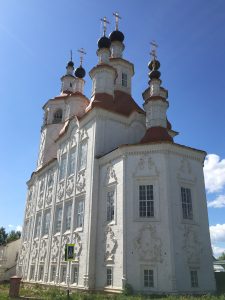
Returning home after lucrative trade, local Totma merchants would donate funds for construction of local churches. This church currently serves as the Seafarers Museum.

Kuskov’s Alaska experience was characterized as a “school of management and administration” and it was said that both Baranov and Kuskov needed “a remarkable organizational talent and tenacity to keep the free-booting Russian promyshlenniki in line, to supply them with provisions and necessities, to organize large parties of Aleuts in kayaks to hunt sea animals, to construct Russian forts and to reconnoitre suitable places for new ones, to defend against unfriendly Tlingit Indians, to build and launch sailing ships, and to establish trade relations with American sea captains who visited the Russian settlements.” - 1
To maximize profits for the state and to regulate unruly promyshlenniki (frontiersmen), competing fur trade companies were monopolized in 1799 by decree into the Russian American Company, and, due to diminishing numbers of nearby sea otters, Russian fur trade initiatives pivoted from the Aleutian Islands and Kodiakto the southeast of Alaska. New Archangel(Sitka) was eventually established as the new capitol of Russian America (not without spirited protest from the native Tlingit).
Kuskov, Baranov’s trusted right hand man, had clearly proven his worth as a loyal and accomplished “company man” and in fact was formally recognized for his service. In 1805, Nikolai Rezanov, visiting Chamberlain to Tsar Alexander I, on his way to Alta California (seeking food and more otters), formally presented to Kuskov for his "diligence" the Order of St. Vladimir, a gold medal placed on a ribbon, to wear around his neck. (Kuskov proudly displays this, over 15 years later, when he posed for his only known portrait - see photo.) Also during this time the Russian American Company's Main Office in St. Petersburg petitioned Tsar Alexander to assign Kuskov the service rank of “Commerce Councillor”.
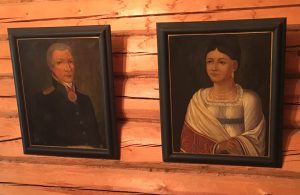
But there was another important life accomplishment, a key person and personal alliance in Ivan Kuskov’s life, usually not mentioned: Ekaterina Prokhorovna. Though according to European Russian archival sources the heritage of Kuskov’s (at first just common law) wife Ekaterina Prokhorovna is unclear (some say she was Alaska Native (Tlingit, Haida or Tsimshian), some say from the Alaska Creole class, others say she was Russian or even East Indian), probably the Alaska Native oral tradition is in fact the most trustworthy source, stating she was of Haida heritage (see accompanying article,Kuskov, An Alaska Native Perspective, by Lauren Peters). Though Ekaterina Prokhorovna’s story and their partnership hasn’t been a part of our dominant narrative at Fort Ross, it appears that she did in fact live with Ivan Alexandrovich throughout the next chapter of his life, in Alta California. (Please watch for more information regarding “the First Lady of Fort Ross” as we work more closely and learn more from our Alaska Native and Russian partners…)
The trajectory of Russian expansion into North America continued. Starting in 1803, the first Russian promyshlenniki and Alaska Native hunters venturing south along the coast from Alaska to Alta and even Baja California, first on American ships. And then Chamberlain Nikolai Rezanov's venture in 1806, sailing into San Francisco Bay which began formal trade negotiations with the Spanish. In 1808 Kuskov was entrusted to head up further Russian voyages to Alta California, which led to establishing in 1809 the Russian Port Rumiantsev(Bodega Bay). And then came Kuskov’s most acclaimed (and best documented) life accomplishment, serving as the founder and first manager (“pravitel”) of Fortress Ross. - 2
Following Kuskov’s service at Fortress Ross (from 1812-1821), the Russian American Company Manager-in-Chief Matvei Muravyov, his last boss, wrote this glowing testimonial of him just prior to departure from New Archangel for Russia in 1822:
Commerce Councillor Ivan Alexandrovich Kuskov has long continued his service in America, to the honor of his own name and for the benefit of his Fatherland. During his most recent assignment in America he commanded the settlement and outpost of Ross, on the shores of New Albion. Mr. Kuskov founded and constructed this fort. He established a shipyard and had three mercantile ships built there, which have been of great use to the Russian-American Company colonies. Amidst savage peoples who lived near the fort, he engaged in stock-raising, horticulture, and some agriculture. He reconciled groups of Indians hostile to one another, and for many years he kept these wild people in friendly relations with those who lived at the fort solely by means of kindness and fairness. He has been under my authority since September 15, 1820, and as a token of my esteem for him I am pleased to testify to his noble conduct, his high level of honesty, and his steadfast zeal for the common welfare of all. His experience and knowledge of local circumstances have been so valuable that it is hard to replace him with anyone at all. I warmly wish him every happiness, and with deep regret I bid him farewell.
Matvei Murav'ev, "Attestat G. Kuskovu," Joe. cit.; printed versions in Chernitsyn, pp. 120-21, and in Kovalev, p. 262. From Ivan Kuskov and the Founding of Fort Ross by Stephen Watrous.

The handsome “ Kuskov House” at Fort Ross State Historic Park, reconstructed in 1983, served as home and headquarters for Ivan Kuskov and the succeeding three managers of Colony Ross (before Alexander Rotchev), and continues to pay tribute to the fort’s founder and first manager. First hand accounts describe its historic use:
The first room we entered was the armory, containing many muskets, ranged in neat order; hence we passed into the chief room of the house, which is used as a dining room & in which all business is transacted. It was comfortably, though not elegantly furnished, and the walls were adorned with engravings of Nicholas I, Duke Constantine...
An (anonymous) Bostonian’s description, 1832.
The old house for the commandant, two stories, built of beams, 8 toises [sazhens] long by 6 wide, covered with double planking. There are 6 rooms and a kitchen.
Inventory for Mr. Sutter, 1841.
After departing from Fortress Ross for Alaska, finally formally marrying Ekaterina en route in Kodiak, and then returning to Siberia, Ivan and Ekaterina Kuskov then returned to his Russian native hometown Totma on July 4th, 1822… where Kuskov died the next year, in 1823. Ivan Alexandrovich is now buried at the Spaso-Sumorin Monasteryin Totma. Ekaterina lived on, eventually remarrying.
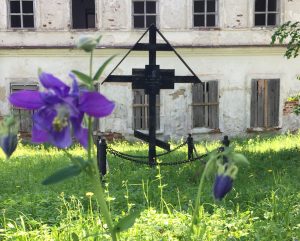

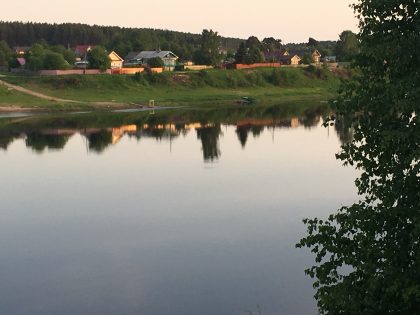

Totma Now
Totma, an unforgettably picturesque northern Russian town, is now home to over 9000 residents. Though long ago the main shipping routes and more recent train routes have bypassed Totma, residents remain very proud of their local and global history, thanks to the legacy left of their numerous native seafarers and explorers, spanning from Totma to Fort Ross and beyond. For a town its size, Totma boasts a multitude of impressive museums, all part of the Totma Association of Museums, led by their dynamic young director Aleksey M. Novosyolov and his talented, energetic and award-winning team. Among others, their museums include the Creative Space AntreSol, an innovative and interactive museum featuring everything you’d ever wanted to know about salt (salt production was central to Totma’s early wealth) and also their Seafarer’s Museum, currently located in the Entry to Jerusalem Church, one of the many tall and narrow “Totma Baroque” churches that resemble tall ships. The compelling legacy of Ivan Kuskov has made him the most acclaimed native son of Totma, and his life story is told in the exhibits and creative interactive programs of the Kuskov House Museum and, thanks to their good work, known well by local children.
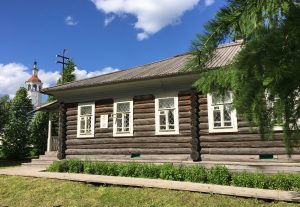

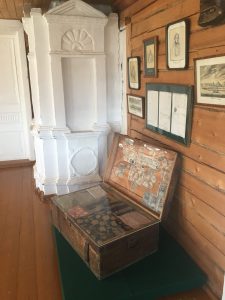

Totma-Fort Ross Bridge
Annually, in mid-August, the residents of Totma gather to celebrate their town and the “Day of Russian America.” Among other weekend festivities, the tradition of a bell bridge and, more recently, also a video bridge, have been established. At one time, the peal of ringing bells spans the continents, from Totma, to Alaska, and to Fort Ross… honoring our shared history and heritage. (Join us! The 2019 bell & video bridge will take place August 9th.) During the 2012 Fort Ross bicentennial commemoration, Totma generously gifted to Fort Ross a set of four cast bronze bells (pictured). Though temporarily in safe keeping at a local Orthodox church, the hope is that one day the chapel at Fort Ross will have a belfry with bells.
Starting early in the 19th century, the shared history and heritage of Totma, Vologda and Fort Ross have created through time an enduring bridge of goodwill and friendship. Delegations from here and there continue to visit each other’s shores, including members of the Kashia tribe being warmly welcomed into the homes of Totma families, plus a Totma delegation scheduled to visit us summer of 2020 (please let us know if you’d like to help us host!). The reconstructed handcrafted windmill that was gifted to Fort Ross by “Links of Time Foundation” for the Fort Ross bicentennial also came from Vologda region. Gifted copies of the original portraits of Alexander and Ekaterina Kuskov, originally framed in California redwood, now hang in the Fort Ross Kuskov House.
Goodwill endures… and prevails (at least at common ground Fort Ross).

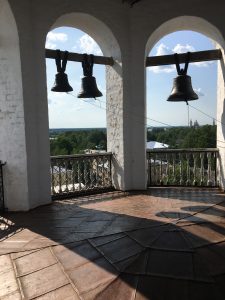
Fly now to Fort Ross, Vologda, Totma, Veliky Ustug or Fort Ross?
Click here for virtual tours!

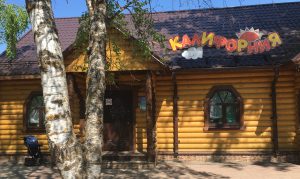
Footnote
- Svetlana G. Fedorova, "Russkaia Amerika i Tot'ma v sud'be Ivana Kuskova" (Russian America and Totma in the Life of Ivan Kuskov), in Problemy istorii i ethnografii Ameriki (Moscow: Nauka, 1979), p. 230.
- Though known as “Fort Ross,” it’s really a “she” not a “he.” The correct translation of “крепость” (“krepost,” the word the Russians used for our fort) is really “fortress” not “fort”.
Kuskov, An Alaska Native Perspective
Lauren Peters, MLIS
Agdaagux^ Tribe, Unangax^
Alaska Native Advisor to Fort Ross Conservancy
Before Ivan Kuskov was the manager at Ross, he was second in command on Kodiak Island under Alexander Baranov. Mr. Kuskov oversaw enforcing the rules spelled out by Baranov. For example, when returning from a trip, Baranov found his “house girl,” Anna, with her chosen mate, a young Kodiak Island man. Kuskov orders were to have the man “run the gauntlet,” shave his head and eyebrows, humiliate him publicly, split his parka open from head to toe, and be sent away to an outlying artel where the only recompense was the lash. Such was the reputation of Kuskov, that even today, people on Kodiak Island say to their disobedient children, “Be careful, or Kuskov will get you!” By the time Kuskov founded Ross in 1812, the Aleutian Islanders (Unangax^) and Kodiak Islanders (Supiaq) had been a conquered people for up to 70 years.
Haida society, like all Alaska Native cultures, is matriarchal. That is, women are the powerful decision makers, form political alliances, and it is from the women that Haida inherit their family line. Kuskov traded with Alaskan tribes as he sailed between what is now Alaska and California. Kuskov’s partner, Ekaterina, was an Alaska Native Noblewoman from Haida Gwaii, a wealthy island which supported many large cities in Southeast Alaska. It would have been her choice to go with Kuskov, knowing that she was creating strong trading ties with the Russians and cementing the protection of her people. Being high born, she would have expected the Russians to treat her as such, fitting for the wife of the manager of Ross. Both Anna and Ekaterina outlived their husbands, both remarrying: Ekaterina in Russia, and Anna on Kodiak. It is said that Anna lived out the remainder of her life on Spruce Island, under the protection of St. Herman of Alaska.
References
Black,L. (2004). Baranov arrives. InRussians in Alaska, 1732-1867(pp.121-138). Fairbanks, AK: University of Alaska Press.
Gibson, J. R., Istomin, A. A., & Tishkov, V. A. (2014). Russian California, 1806-1860: : a history in documents. London: Ashgate.
Kennedy, R (2019) Personal conversation with Haida gentleman (Oral History)
Vlasoff,B. (2007).Our Kotel'nikov Journey from Okhotsk, to Fort Ross, to Ouzinkie: An Alaskan Family's